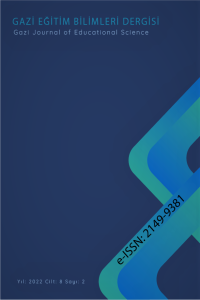DİNAMİK GEOMETRİ YAZILIMI CABRİ’NİN MATEMATİK EĞİTİMİNDE KULLANIMI: PİSAGOR BAĞINTISI VE ÇOKGENLERİN DIŞ AÇILARI
Teknolojinin matematik eğitiminde kullanılmasıyla birlikte sınıf ortamlarındaki uygulamalarda da değişimler meydana gelmiştir. Bu ortamlarda kullanılan dinamik geometri yazılımları, geometri öğretiminde öğrencilere geometrik yapılar üzerinde varsayımlarda bulunmalarına, varsayımlarını test etme ve genelleme yapma fırsatı vermiştir. Dinamik Geometri Yazılımları (DGY)’nin sahip olduğu sürükleme özelliği yardımıyla, öğrenci şeklin özelliklerini değiştirirken değişmeyen ilişkileri gözleyerek keşfedebilir. Bu keşif öğrenciye çok güçlü bir varsayımda bulunma imkânı sağlar. Ardından öğrenci bu varsayımını birçok örnekle destekleyebilir ya da reddedebilir. Geleneksel ortamlarda görülemeyen, oluşturulamayan birçok ilişki ve özellikler oluşturulup araştırabilmekte ve böylece genelleme rahatlıkla çalışılabilmektedir Çalışmada öğrencilerin öğrenmelerine katkı sağlayacak ve öğretmenlerin sınıf ortamında kullanabilecekleri iki etkinlik örneği verilmiştir. Öğrenciler, etkinliklerde Pisagor bağıntısı ve çokgenlerin dış açıları toplamını keşfetme imkânı elde edecekler ve genellemelere ulaşacaklardır.
Anahtar Kelimeler:
Pisagor bağıntısı, Çokgenler, Dinamik Geometri Yazılımı
USING DYNAMIC GEOMETRY SOFTWARE CABRI IN MATHEMATICS EDUCATION: PYTHAGOREAN RELATIONSHIP AND EXTERIOR ANGLES OF POLYGONS
A change in practice in the classroom with the use of technology in mathematics education has occurred. Dynamic geometry software used in these environments has given students the opportunity to make their assumptions on the geometric structures, to test their assumptions and to make their generalizations. With the help of the "dragging" feature of Dynamic Geometry Software (DGS), students can discover by observing the invariant relationships while changing the properties of the shape. This discovery allows students the opportunity to make very strong assumptions. Then students can support or reject their assumptions with many examples. Many relationships and properties can be created and then be explored that are not seen and created in traditional media thereby generalizations can easily be studied. In this study, it has been given two examples of activities that both teachers can use in their classrooms and contribute to students’ learning. In the activities, students will have the opportunity to discover the Pythagorean relationship and the total sum of the exterior angles of polygons and thus they will reach generalizations.
Keywords:
Pythagorean relationship, Polygons, Dynamic Geometry Software,
- ISSN: 2149-4932
- Yayın Aralığı: Yılda 3 Sayı
- Başlangıç: 2015
- Yayıncı: Aydın KARAPINAR
Sayıdaki Diğer Makaleler
ARTIRILMIŞ GERÇEKLİK TEKNOLOJİSİ İLE İNGİLİZCE KELİME ÖĞRETİMİNİN ÖĞRENCİ PERFORMANSINA ETKİSİ
Recep ÇAKIR, Ekrem SOLAK, Sabri Serkan TAN
ORTAOKUL ÖĞRENCİLERİNİN ÖĞRENME STİLLERİ İLE BAZI DEĞİŞKENLER ARASINDAKİ İLİŞKİNİN ARAŞTIRILMASI
Orhan KARAMUSTAFAOĞLU, Emine YURTYAPAN, Övgü ÇOŞKUN, Ömer Faruk DİVARCI, Mahsuni DERİN
